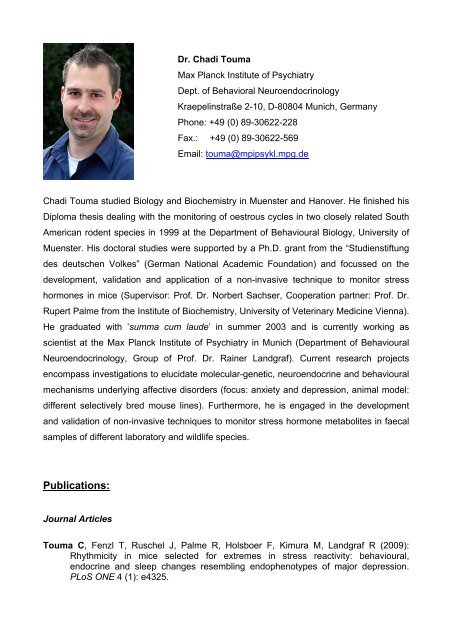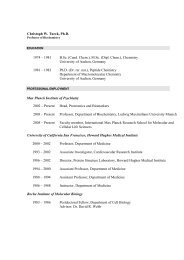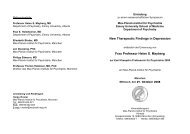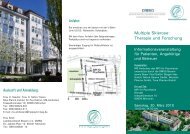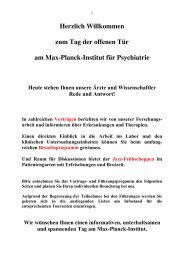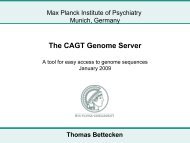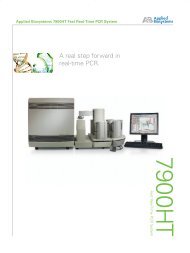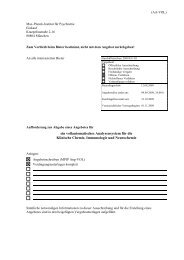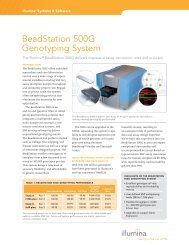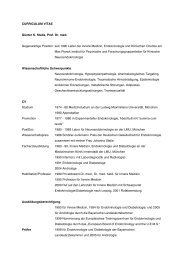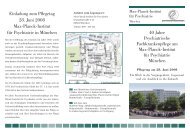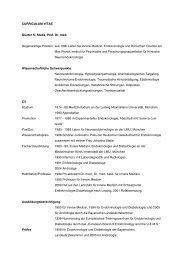Chadi Touma - Max-Planck-Institut für Psychiatrie München
Chadi Touma - Max-Planck-Institut für Psychiatrie München
Chadi Touma - Max-Planck-Institut für Psychiatrie München
You also want an ePaper? Increase the reach of your titles
YUMPU automatically turns print PDFs into web optimized ePapers that Google loves.
Dr. <strong>Chadi</strong> <strong>Touma</strong><br />
<strong>Max</strong> <strong>Planck</strong> <strong>Institut</strong>e of Psychiatry<br />
Dept. of Behavioral Neuroendocrinology<br />
Kraepelinstraße 2-10, D-80804 Munich, Germany<br />
Phone: +49 (0) 89-30622-228<br />
Fax.: +49 (0) 89-30622-569<br />
Email: touma@mpipsykl.mpg.de<br />
<strong>Chadi</strong> <strong>Touma</strong> studied Biology and Biochemistry in Muenster and Hanover. He finished his<br />
Diploma thesis dealing with the monitoring of oestrous cycles in two closely related South<br />
American rodent species in 1999 at the Department of Behavioural Biology, University of<br />
Muenster. His doctoral studies were supported by a Ph.D. grant from the “Studienstiftung<br />
des deutschen Volkes” (German National Academic Foundation) and focussed on the<br />
development, validation and application of a non-invasive technique to monitor stress<br />
hormones in mice (Supervisor: Prof. Dr. Norbert Sachser, Cooperation partner: Prof. Dr.<br />
Rupert Palme from the <strong>Institut</strong>e of Biochemistry, University of Veterinary Medicine Vienna).<br />
He graduated with ’summa cum laude’ in summer 2003 and is currently working as<br />
scientist at the <strong>Max</strong> <strong>Planck</strong> <strong>Institut</strong>e of Psychiatry in Munich (Department of Behavioural<br />
Neuroendocrinology, Group of Prof. Dr. Rainer Landgraf). Current research projects<br />
encompass investigations to elucidate molecular-genetic, neuroendocrine and behavioural<br />
mechanisms underlying affective disorders (focus: anxiety and depression, animal model:<br />
different selectively bred mouse lines). Furthermore, he is engaged in the development<br />
and validation of non-invasive techniques to monitor stress hormone metabolites in faecal<br />
samples of different laboratory and wildlife species.<br />
Publications:<br />
Journal Articles<br />
<strong>Touma</strong> C, Fenzl T, Ruschel J, Palme R, Holsboer F, Kimura M, Landgraf R (2009):<br />
Rhythmicity in mice selected for extremes in stress reactivity: behavioural,<br />
endocrine and sleep changes resembling endophenotypes of major depression.<br />
PLoS ONE 4 (1): e4325.
Blottner D, Serradj N, Salanova M, <strong>Touma</strong> C, Palme R, Silva M, Aerts JM, Berckmans D,<br />
Vico L, Liu Y, Guiliani A, Rustichelli F, Cancedda R, Jamon M (2009):<br />
Morphological, physiological and behavioural evaluation of a ‘Mice in Space’<br />
housing system. Journal of Comparative Physiology B in press.<br />
Ibarguen-Vargas Y, Surget A, <strong>Touma</strong> C, Palme R, Blezung C (2008): Multifaceted strainspecific<br />
effects in a mouse model of depression and of antidepressant reversal.<br />
Psychoneuroendocrinology 33: 1357-1368.<br />
<strong>Touma</strong> C, Bunck M, Glasl L, Nussbaumer M, Palme R, Stein H, Wolferstätter M, Zeh R,<br />
Zimbelmann M, Holsboer F, Landgraf R (2008): Mice selected for high versus low<br />
stress reactivity: a new animal model for affective disorders. Psychoneuroendocrinology<br />
33: 839-862.<br />
Lepschy M, Rettenbacher S, <strong>Touma</strong> C, Palme R (2008): Excretion of catecholamines in<br />
rats, mice and chicken. Journal of Comparative Physiology B 178: 629-636.<br />
Richter H, Ambrée O, Lewejohann L, Herring A, Keyvani K, Paulus W, Palme R, <strong>Touma</strong><br />
C, Schäbitz WR, Sachser N (2008): Wheel running in a transgenic mouse model of<br />
Alzheimer’s disease: protection or symptom? Behavioral Brain Research 190: 74-<br />
84.<br />
Lepschy M, <strong>Touma</strong> C, Hruby R, Palme R (2007): Non-invasive measurement of<br />
adrenocortical activity in male and female rats. Laboratory Animals 41: 372-387.<br />
Dallmann R, <strong>Touma</strong> C, Palme R, Albrecht U, Steinlechner S (2006): Impaired daily<br />
glucocorticoid rhythm in Per1 Brd and Per2 Brd mice. Journal of Comparative<br />
Physiology A 192: 769-775.<br />
Voigtländer T, Unterberger U, <strong>Touma</strong> C, Palme R, Polster B, Strohschneider M, Dorner S,<br />
Budka H (2006): Prominent corticosteroid disturbance in experimental prion<br />
disease. European Journal of Neuroscience 23: 2723-2730.<br />
Ambrée O, <strong>Touma</strong> C, Görtz N, Keyvani K, Paulus W, Palme R, Sachser N (2006): Activity<br />
changes and marked stereotypic behavior precede Aβ pathology in TgCRND8<br />
Alzheimer mice. Neurobiology of Aging 27: 955-964.<br />
<strong>Touma</strong> C, Palme R (2005): Measuring fecal glucocorticoid metabolites in mammals and<br />
birds: the importance of validation. Annals of the New York Academy of Sciences<br />
1046: 54-74. (review paper)<br />
Palme R., Rettenbacher S, <strong>Touma</strong> C, El Bahr S, Möstl E (2005): Stress hormones in<br />
mammals and birds: Comparative aspects regarding metabolism, excretion and<br />
noninvasive measurement in fecal samples. In: Trends in Comparative<br />
Endocrinology and Neurobiology. Annals of the New York Academy of Sciences<br />
1040: 162-171.<br />
<strong>Touma</strong> C, Ambrée O, Görtz N, Keyvani K, Lewejohann L, Palme R, Paulus W, Schwarze-<br />
Eicker K, Sachser N (2004): Age- and sex-dependent development of<br />
adrenocortical hyperactivity in a transgenic mouse model of Alzheimer’s disease.<br />
Neurobiology of Aging 25: 893-904.
<strong>Touma</strong> C, Palme R, Sachser N (2004): Analyzing corticosterone metabolites in fecal<br />
samples of mice: a noninvasive technique to monitor stress hormones. Hormones<br />
and Behavior 45: 10-22.<br />
<strong>Touma</strong> C, Sachser N, Möstl E, Palme R (2003): Effects of sex and time of day on<br />
metabolism and excretion of corticosterone in urine and feces of mice. General and<br />
Comparative Endocrinology 130: 267-278.<br />
<strong>Touma</strong> C, Palme R, Sachser N (2001): Different types of oestrous cycles in two closely<br />
related South American rodents (Cavia aperea and Galea musteloides) differing in<br />
social and mating systems. Reproduction 121: 791-801.<br />
Book Chapters and Editorials<br />
Hambsch B, Czibere L, Landgraf R, <strong>Touma</strong> C (2009): Genetic transmission of behavior<br />
and its neuroendocrine correlates. In: Pfaff D, Arnold AP, Etgen AM, Fahrbach SE,<br />
Rubin RT (Eds.): Hormones, Brain and Behavior 2 nd ed., Elsevier Science, San<br />
Diego CA, USA pp. (in press).<br />
Kaiser S, <strong>Touma</strong> C, Galert T, Würbel H (2008): Animal suffering – fact or fiction? In: Müller<br />
K, Sachser N (Eds.): Theology Meets Biology – Anthropological Perspectives on<br />
Animals and Human Beings. Pustet Verlag, Regensburg, pp. 123-136.<br />
Jömann N, Junker C, <strong>Touma</strong> C (Eds.) (2004): Religion - wieso, weshalb, warum? Zur<br />
Funktion von Religion aus soziologischer, biologischer, philosophischer und<br />
theologischer Sicht. Reihe: Edition KSHG, Bd. 3, 160 Seiten, LIT Verlag Münster-<br />
Hamburg-Berlin-Wien-London.<br />
<strong>Touma</strong> C, Kurt F (2001): Ethologische Untersuchungen zur Musth bei Elefantenbullen in<br />
Menschenhand. In: Kurt F (Ed.): Elefant in Menschenhand – Forschungsberichte<br />
aus Sri Lanka. Filander Verlag, Fürth, pp. 185-196.<br />
Published Abstracts of Posters and Oral Contributions<br />
<strong>Touma</strong> C, Knapman A, Palme R, Holsboer F, Landgraf R (2008): Mice selected for<br />
extremes in stress reactivity: modelling clinically relevant endophenotypes of major<br />
depression. Proceedings of the Society for Neuroscience, Washington, DC<br />
357.1/CC3. (Poster)<br />
Wolferstätter M, Glasl L, Marwedel AL, Bunck M, Landgraf R, <strong>Touma</strong> C (2007): Linking<br />
cognitive abilities and stress reactivity: insights from the HR/IR/LR mouse model.<br />
Pharmacopsychiatry 40: 218. (Poster)
Nicholson A, Malcolm R, Russ P, Cough K, Palme R, <strong>Touma</strong> C, Wiles M (2007):<br />
Physiological responses to increased housing density in C57BL/6J mice. Journal of<br />
the American Association for Laboratory Animal Science 46: 92. (Poster)<br />
<strong>Touma</strong> C, Bunck M, Stein H, Zeh R, Landgraf R (2006): Mice selected for high or low<br />
stress reactivity: a new animal model for affective disorders. Frontiers in<br />
Neuroendocrinology 27: 56. (Poster)<br />
Frank E, Kessler MS, Bunck M, Czibere L, <strong>Touma</strong> C, Landgraf R (2006): Freely<br />
segregating genes – a link to anxiety and depression. Hormones 5, Supplement 1,<br />
pp. 84. (Poster)<br />
<strong>Touma</strong> C, Bunck M, Keßler M, Nußbaumer M, Landgraf R (2005): Mice selected for high<br />
or low stress reactivity: a proposed model for affective disorders.<br />
Pharmacopsychiatry 38: 281. (Poster)<br />
Ambrée O, Görtz N, Keyvani K, Lewejohann L, Palme R, Paulus W, <strong>Touma</strong> C, Sachser N<br />
(2005): Early behavioural and hormonal alterations in TgCRND8 Alzheimer mice. In:<br />
Hossmann K.A. (ed.): Neurovisionen 2 - Perspektiven in NRW. Verlag Ferdinand<br />
Schöningh, Paderborn: 194-195. (Poster)<br />
<strong>Touma</strong> C, Sachser N, Möstl E, Palme R (2005): Non-invasive monitoring of stress<br />
hormones in mice: a technique opening new perspectives in biomedical and animal<br />
welfare research. ALTEX 22, Supplement, pp. 56. (Talk)<br />
<strong>Touma</strong> C, Ambrée O, Görtz N, Isenberg S, Keyvani K, Lewejohann L, Palme R, Paulus W,<br />
Schwarze-Eicker K, Sachser N (2004): Behavioral and endocrine alterations in a<br />
mouse model of Alzheimer’s disease: early indicators of neuropathological<br />
changes? Hormones and Behavior 46: 103. (Poster)<br />
<strong>Touma</strong> C, Palme R, Sachser N (2004): Non-invasive monitoring of stress hormones in<br />
mice: a technique opening new perspectives in biomedical and animal welfare<br />
research. In: Contributions to the UFAW Symposium on Science in the Service of<br />
Animal Welfare, Edinburgh, UK, Animal Welfare 13, Supplement, pp. S256-257.<br />
(Poster)<br />
<strong>Touma</strong>, C, Palme, R, Sachser, N (2003): Analysing stress hormone metabolites in faecal<br />
samples of mice: a non-invasive technique opening new perspectives in biomedical<br />
and animal welfare research. ALTEX 20: 204. (Talk)<br />
Sachser N, Ambrée O, Görtz N, Keyvani K, Lewejohann L, Palme R, Paulus W, <strong>Touma</strong> C<br />
(2003): Behavioral and endocrinological characterization of a transgenic mouse<br />
model of the Alzheimer disease. Hormones and Behavior 44: 73-74. (Poster)<br />
<strong>Touma</strong> C, Palme R, Möstl E, Sachser N (2002): Non-invasive monitoring of stress<br />
hormones in mice by analysing faecal corticosterone metabolites. In: Contributions<br />
to the 4 th International Symposium on Physiology and Behaviour of Wild and Zoo<br />
Animals, Berlin, Advances in Ethology 37, Supplements to Ethology, pp. 175. (Talk)<br />
<strong>Touma</strong> C, Sachser N, Möstl E, Palme R (2002): Analysis of faecal glucocorticoid<br />
metabolites: A non-invasive technique to monitor adrenocortical activity in
laboratory mice. In: Contributions to the 4 th World Congress on Stress, Edinburgh,<br />
UK, Stress 5, Supplement, pp. 69. (Poster)<br />
Palme R, <strong>Touma</strong> C, Sachser N, Möstl E (2001): Glucokortikoidausscheidung bei<br />
Labormäusen: Möglichkeit einer nicht-invasiven Erfassung von Belastungen.<br />
ALTEX 18: 207-208. (Poster)<br />
<strong>Touma</strong> C, Palme R, Sachser N (2001): Monitoring of oestrous cycles by analysing faecal<br />
hormones in two rodent species. In: Contributions to the XXVII International<br />
Ethological Conference, Tübingen, Advances in Ethology 36, Supplements to<br />
Ethology, pp 277. (Talk)<br />
<strong>Touma</strong> C, Palme R, Sachser N (2001): Analysis of faecal hormones: A non-invasive<br />
technique to monitor reproductive cycles in two rodent species. Zoology 104,<br />
Supplement IV (DZG 94.1), pp. 9. (Talk)<br />
<strong>Touma</strong> C, Palme R, Sachser N (2000): Non-invasive monitoring of reproductive cycles in<br />
two closely related South American rodent species. In: Contributions to the 3 rd<br />
International Symposium on Physiology and Ethology of Wild and Zoo Animals,<br />
Berlin, Advances in Ethology 35, Supplements to Ethology, pp. 105. (Talk)<br />
<strong>Touma</strong> C, Kaiser S, Palme R, Sachser N (2000): Different types of oestrous cycles in two<br />
closely related rodent species differing in social and mating system. Zoology 103,<br />
Supplement III (DZG 93.1), pp. 37. (Poster)<br />
<strong>Touma</strong> C, Asher M, Sachser N (1998): Social structure in a group of Vietnam Sika deer in<br />
the Allwetterzoo Münster. In: Contributions to the 2 nd International Symposium on<br />
Physiology and Ethology of Wild and Zoo Animals, Berlin, Advances in Ethology 33,<br />
Supplements to Ethology, pp. 45. (Poster)


